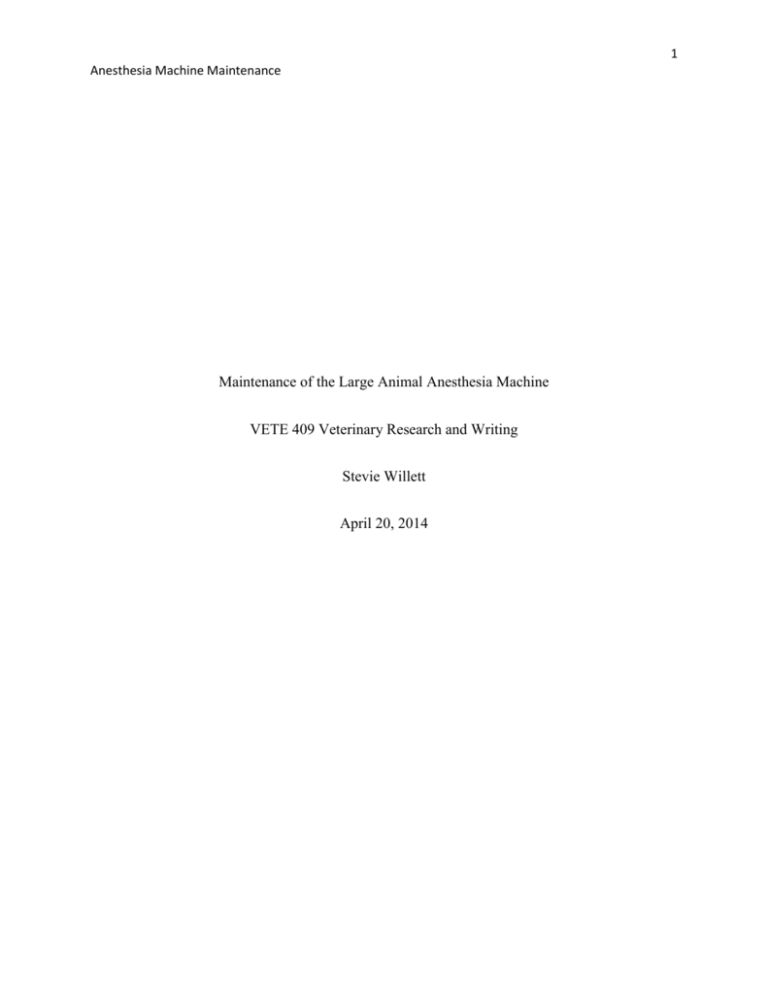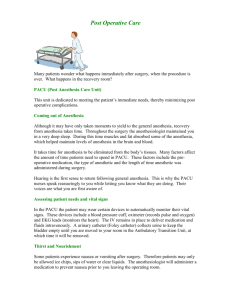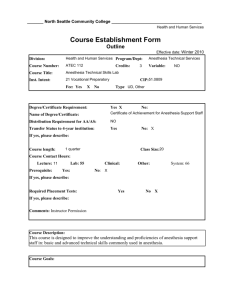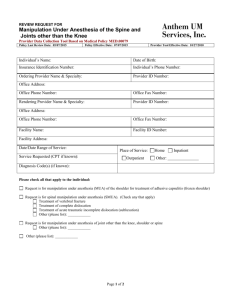File
advertisement

1 Anesthesia Machine Maintenance Maintenance of the Large Animal Anesthesia Machine VETE 409 Veterinary Research and Writing Stevie Willett April 20, 2014 2 Anesthesia Machine Maintenance Introduction: The anesthesia machine is one of the most important pieces of equipment in a veterinary hospital, and many veterinary practices use this piece of equipment on a daily basis. The primary function of any anesthetic machine is to deliver precise amounts of oxygen and volatile anesthetic under controlled conditions to patients undergoing general anesthesia (Thomas and Lerche 2011). Maintaining this piece of equipment can help to contribute to a successful surgery. This project evaluation will focus strictly on the maintenance of the large animal anesthesia machine. Purpose of Project: The purpose of this project is to help prevent errors from occurring with the large animal anesthesia machine during use, which will also help to prevent complications with patients while under gas anesthesia. Proper maintenance of an anesthesia machine can prevent machine failure during use. A properly running anesthesia machine can contribute to a decreased number of patient deaths under general anesthesia. Goals for the Project: There are several reasons why this project was selected. Most veterinary hospitals have different anesthesia machine maintenance protocols, while other hospitals have no protocols. The goals for this project are to precisely describe how to pressure check the large animal anesthesia machine, and to set up the machine for use on the patient. An additional goal that is also very 3 Anesthesia Machine Maintenance important is to clearly define how to clean the large animal anesthesia machine after it has been used. Activities Performed: There are many activities that contribute to the maintenance of a large animal anesthesia machine. Some of these activities are performed prior to being connected to the patient or performed after the patient has been disconnected and surgery has been completed. Prior to surgery perform a leak check: 1. Check that oxygen tanks have oxygen and both tanks are connected to the system (at least one tank must be completely full). 2. Turn on one oxygen tank (if there is a partial tank, use that one first). 3. Connect the male end of the green oxygen line (from the anesthesia machine) to the female oxygen connection (from the ceiling). 4. Make sure that the dial for the oxygen flow meter is turned completely off (do not forcefully over turn this knob). 5. Connect the Y piece to the anesthesia machine. 6. Connect the 30 L black reservoir bag to the manifold. 7. Turn the pop-off valve to the ‘off’ position. 8. Hold your hand over the end of the Y piece firmly to make an airtight seal. 9. Push the flush valve next to the oxygen flow meter and fill the reservoir bag. Continue to use the flush valve until the pressure gauge on the anesthesia machine (not the ventilator) rises just above 20 cm H2O. 4 Anesthesia Machine Maintenance 10. Continue to hold your hand over the Y piece for 30 seconds. The pressure gauge should not fall more than 3 cm H20 in 30 seconds. 11. If the machine holds pressure, it passes the leak test. The machine should then be set for surgery. 12. If the pressure does not hold, there is a leak. Prior to Surgery-Patient Setup: This procedure is performed only after a leak test has been performed. 1. If you will be administering anesthesia without a ventilator and allowing the horse to breathe off of the reservoir bag, open the pop-off valve and connect the blue exhaust tubing to the pop-off valve. 2. If you will be administering anesthesia with a ventilator, leave the pop-off valve closed, remove the reservoir bag, connect the ventilator to the manifold, and connect the blue exhaust tubing to the ventilator. Plug in the ventilator. 3. Connect the other end of the exhaust tubing to the ceiling exhaust and turn on the fan. 4. Make sure that the vaporizer is full or add more of the correct volatile anesthetic to the vaporizer to ensure that it will be full prior to the patient being connected. 5. Prime the machine with gas: 5-10 minutes prior to the start of surgery, seal the end of the Y piece (exam gloves work best) and turn the oxygen flow meter to 1 liter and turn the isoflurane vaporizer to 3%. This is called priming the machine. Post anesthesia activities- machine cleaning: Once the patient has been disconnected from the anesthetic machine and moved to recovery. 1. Turn oxygen off and disconnect oxygen line. 5 Anesthesia Machine Maintenance 2. Remove Y piece and rinse well with water and clean with chlorhexadine gluconate. Rinse well after cleaning and then hang to dry. 3. Unscrew and detach the unidirectional valves. Clean the canister and valves with chlorhexadine gluconate and water. Dry valves thoroughly before reattaching to anesthesia machine. 4. Unscrew and detach carbon dioxide absorber canister. Dispose of soda lime granules if needed and replace with fresh new granules. Clean inside of canister with chlorhexidine gluconate and water then dry inside of canister prior to refilling. 5. After cleaning and reattaching pieces of equipment to the anesthesia machine complete a leak check. Expected Outcomes: Like with all other pieces of veterinary equipment, the large animal anesthesia machine requires proper maintenance. Having maintenance activities performed before and after the use of the anesthesia machine can help to prevent some possible complications with the patient during anesthesia. The maintenance procedures, such as cleaning particular pieces of the anesthesia machine, can also prevent the spread of infectious diseases form one animal to the next. The people who work with a large animal anesthesia machine will be able to be more confident and comfortable with the machine by knowing how to assemble and disassemble it. Reasons to Evaluate Project: As previously mentioned, many veterinary hospitals have their own anesthesia machine maintenance protocols, but some hospitals do not. This project was chosen to help everyone who uses the large animal anesthesia machine to become a master at disassembling, cleaning, and 6 Anesthesia Machine Maintenance assembling the large animal anesthesia machine. This ensures that before and after every patient the anesthesia machine is functioning properly. Evaluation Methods: While evaluating this project I found it important to research why an anesthesia machine should be maintained properly and should be cleaned after each use. At times sick animals need to be maintained under general anesthesia with an anesthetic machine, which can then cause the anesthesia machine to become a vector for infectious diseases. This can be very important when using the anesthesia machine on an infectious respiratory case, such as a Streptococcus equi (Strangles) in a horse. It is also important to ensure that all personnel that work with the large animal anesthesia machine know how to properly work the machine. Conclusion: Proper cleaning and maintenance of the large animal anesthesia machine can have many benefits, such as keeping the machine properly working for a long period of time. Additionally proper maintenance can reduce the risk of patient death under anesthesia. Sometimes sick animals that are harboring diseases must be put under general anesthesia for treatment, but with the knowledge of knowing how to properly clean the anesthetic machine after use can eliminate the spread of those diseases to other patients. Finally it is important to properly train personnel in the methods of anesthesia machine maintenance that’s includes, assembling, cleaning and disassembling of the machine. 7 Anesthesia Machine Maintenance References: Thomas, John A. and Lerche, Phillip (2011). Anesthesia and Analgesia for Veterinary Technicians. St. Louis, Missouri: Mosby Elsevier.




